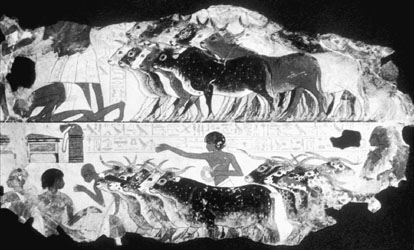

 | Page 427 |  |
years as minimal intervention. The process of increasing control is also known as “the emergence of food production,” representing a shift in focus from the end product (the dead animal or harvested plant) to the living organism and its secondary products (such as milk or wool or seeds for replanting) (Meadow 1984).

Painting of herdsmen with cattle, from the tomb of Nebarnun, 1400 B.C.
(Image Select)
Food production and domestication are visible in the archaeological record through such sources as (1) metric evidence (size), (2) morphology (shape), (3) age/sex profile in an archaeological assemblage, and (4) geography (presence of a species outside its natural range) (Bogucki 1999). In general, domesticated plants increase in size as people select for higher yield per plant, and domesticated animals decrease in size as people select for docility. Morphological changes in plants include the shift from a brittle to a flexible rachis (the stem connecting the seed to the stalk), as people harvest and cultivate seeds that remain on the plant after others have scattered. In animals, morphological changes include the twisting and spiraling shapes of horn cores in goats and sheep and an increase in meat and wool bearing. Animal domestication also results in the retention of juvenile physical characteristics into adulthood, such as short muzzles in dogs and small tusks in pigs.
Quantities and proportions of plants as well as the age and sex profile of animals at a site can be used to distinguish economic strategies ranging from hunting and gathering to cultivation and pastoralism. A concentration of a few plant species may indicate intensive gathering or cultivation rather than opportunistic collection. A large quantity of immature animals in a faunal profile rather than a generalized assemblage could reflect domesticated herds in which only a few older individuals were kept for breeding. Finally, the spread of plant and animal species outside their ancestral range can usually be linked to human intervention and encouragement.
Although animal and plant domestication arose independently in several parts of the world, the search for the earliest origins of agriculture has focused on three archaeological regions in the Near East: the Levant (israel, Syria, and jordan), Anatolia (modern turkey), and the Zagros Mountains (iran and Iraq). The Natufian culture of the Levant (12,500 years ago) has been identified with the earliest sedentary communities, dependent on the harvesting of wild cereals and the hunting of gazelles at
 |  |